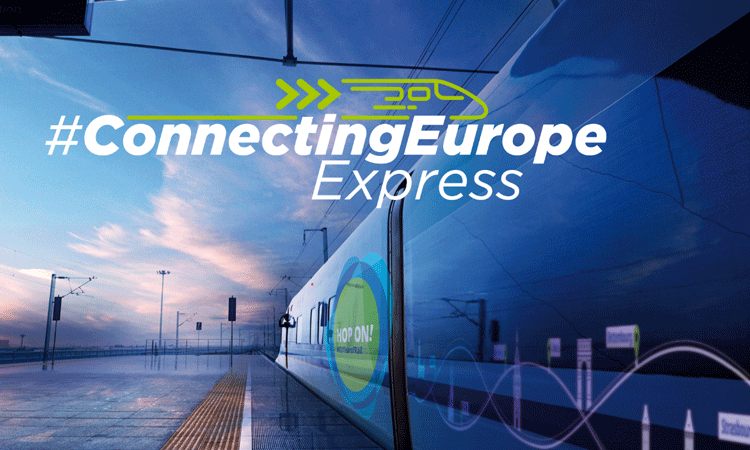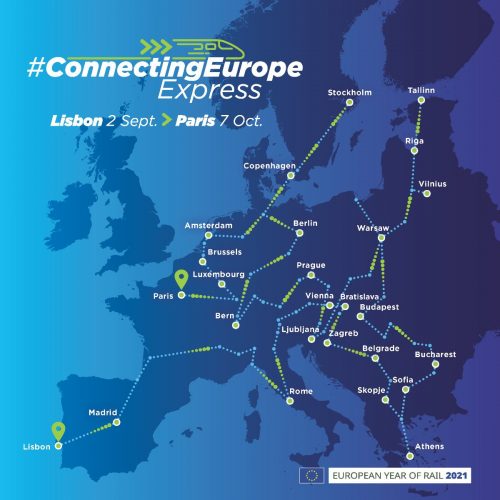Connecting Europe Express reaches Paris after travelling across Europe
Posted: 7 October 2021 | Global Railway Review | No comments yet
After travelling 36 days across Europe, including 120 stops, 26 countries, and 33 borders, the Connecting Europe Express has arrived in its final destination of Paris.


Credit: Connecting Europe Express
Today (7 October 2021) the Connecting Europe Express reached its final destination of Paris after 36 days travelling across Europe – West to East, North to South, and even visiting neighbours outside the EU. This train was specially put together for the occasion of the European Year of Rail 2021, aiming to raise awareness of the benefits of rail and the challenges which still need to be overcome. The train made over 120 stops, crossed 26 countries and 33 borders, travelling on three different gauges along the way.
Adina Vălean, Commissioner for Transport said: “The Connecting Europe Express has been a rolling laboratory, revealing in real-time the many achievements of our Single European Rail Area and our TEN-T network to allow for seamless travel across our Union. I would like to extend my heartfelt gratitude to everyone who helped us turn the Connecting Europe Express from an idea into reality, a packed and exciting itinerary, memorable meetings – of minds and persons – and a true flag-bearer for European rail.”
“The Connecting Europe Express has achieved two targets today. Not only has it reached its final destination in Paris but, more importantly, it has highlighted the challenges in cross-border train services,” commented Andreas Matthä, Community of European Railway and Infrastructure Companies (CER) Chair and CEO of Austrian Federal Railways. “If another important target, the Green Deal, is to be a success, it must become as easy to drive a train through EU as it is to drive a truck. For this to be achieved, rail will need more capacity and new investments in infrastructure. Framework conditions must be adapted to create a level playing field between all modes of transport. I congratulate and thank everyone involved in this highly successful project.”
The final event in Paris was an opportunity to present the initial conclusions drawn during the unique train journey.
- First, for rail to unleash its potential, a true cross-border, modern, high-quality rail infrastructure is a basic requirement. There is a clear need for joint action to complete the Trans-European Transport Network (TEN-T): the core network by 2030, and the comprehensive network by 2050. The Commission will propose changes to the TEN-T Regulation later this year (2021). On 16 September 2021, a €7 billion call for proposals under the Connecting Europe Facility (CEF) was launched, for projects targeting new, upgraded and improved European transport infrastructure. The EU’s Recovery and Resilience Facility can support the modernisation and interoperability of rail infrastructure, plus key infrastructure projects, such as the Lyon-Turin lines, the Brenner Base tunnel, and Rail Baltica.
- Second, existing infrastructure must be better managed and its capacity improved. Digitalisation can help. For example, deploying the European Rail Traffic Management System (ERTMS) will increase capacity, safety, reliability, and punctuality. Research and innovation will also unlock more capacity, and the new ‘Europe’s Rail’ partnership will build on the successful work of Shift2Rail.
- Third, greater pan-European coordination and common requirements are needed, and the Single European Rail Area must be enhanced. For example, Europe’s train drivers should be able to accompany their trains across borders, just as pilots and truck lorry drivers can. The 4th railway package must be transposed quickly to eliminate other remaining obstacles created by national rules and establish an open and competitive European market for rail – technically, operationally, and commercially.
- Fourth, rail needs to become more attractive to encourage more people and companies to choose rail. Improving ticketing and options for planning travel across transport modes would help, as would lowering the costs of rail travel in comparison to the alternatives. Against this backdrop, the Commission will present an Action Plan to boost long-distance cross-border passenger rail services in December 2021.


Credit: Connecting Europe Express
Background
The Connecting Europe Express has been a collective European achievement. It has brought together national, regional and local authorities, society at large and the rail sector, from new entrants and incumbent operators to infrastructure managers and the supply industry. More than 40 partners from the sector joined forces to combine an Austrian sleeper coach with an Italian dining coach, a Swiss panoramic coach, a German seating coach, a French conference coach and a Hungarian exhibition coach; completing the standard gauge train with an Iberian and Baltic train. The railway sector association CER coordinated the technical and operational running of the trains with the 40 plus railway actors involved.
Stay Connected with Global Railway Review — Subscribe for Free!
Get exclusive access to the latest rail industry insights from Global Railway Review — all tailored to your interests.
✅ Expert-Led Webinars – Gain insights from global industry leaders
✅ Weekly News & Reports – Rail project updates, thought leadership, and exclusive interviews
✅ Partner Innovations – Discover cutting-edge rail technologies
✅ Print/Digital Magazine – Enjoy two in-depth issues per year, packed with expert content
Choose the updates that matter most to you. Sign up now to stay informed, inspired, and connected — all for free!
Thank you for being part of our community. Let’s keep shaping the future of rail together!
Related topics
Digitalisation, European Rail Traffic Management System (ERTMS), Infrastructure Developments, Operational Performance, Rolling Stock Orders/Developments, Route Development, Safety
Related organisations
Community of European Railway and Infrastructure Companies (CER), Europe’s Rail Joint Undertaking (EU-Rail), ÖBB, Rail Baltica/RB Rail AS







